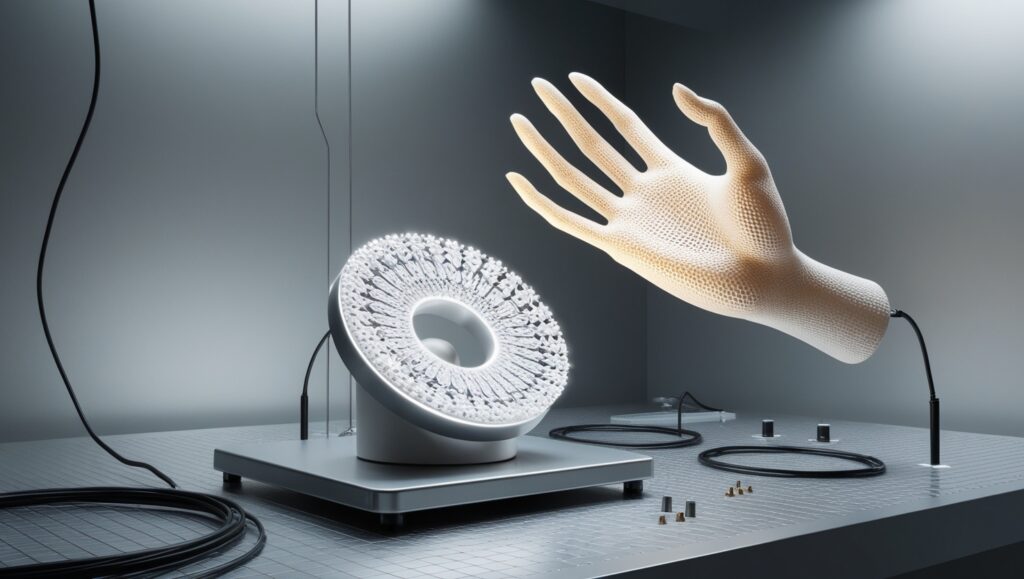
Introduction to Tactile Sensing With 3D Micro Strain Gauges
Tactile sensing with 3D micro strain gauges refers to the use of advanced sensor technologies that enable the detection of various physical stimuli, such as pressure, strain, and temperature, through flexible and adaptable sensors. These sensors are integral to the development of electronic skin, intelligent robotics, and wearable medical devices, enhancing human-computer interactions and enabling more responsive robotic systems.
The significance of tactile sensing lies in its ability to mimic human skin’s sensory capabilities, which is crucial for applications that require intricate tactile feedback and real-time monitoring of physiological signals. Recent advancements in fabrication techniques, particularly 3D printing, have revolutionized the production of tactile sensors, allowing for the creation of complex geometries and customized microstructures that can effectively translate tactile stimuli into electrical signals.
This innovation has facilitated the integration of multifunctional capabilities in sensors, promoting their versatility across various applications. The ongoing research aims to enhance sensor sensitivity, durability, and adaptability to meet the complex demands of real-world environments, making these technologies increasingly relevant in robotics, healthcare, and consumer electronics.
Despite the advantages, challenges remain, including data management and communication reliability, which can hinder the efficiency of tactile sensing systems.
Moreover, the complexities of advanced fabrication methods may pose obstacles to mass production and scalability. As research continues to address these limitations, tactile sensing technologies are poised to play a pivotal role in shaping the future of human-robot interaction and medical diagnostics, potentially revolutionizing how devices engage with users.
Background
Tactile sensors are crucial for enhancing human-computer interactions, wearable medical devices, and intelligent robotic systems, as they enable effective detection of various physical variables such as pressure, strain, and temperature from the external environment.
The development of flexible tactile sensors has significantly advanced in recent years, propelled by innovations in materials and processing methods aimed at fulfilling complex structural requirements and personalized monitoring needs.
Advanced Fabrication Techniques
Traditional fabrication methods, while established, often fail to meet the demands of intricate designs and customization.
Consequently, a variety of advanced manufacturing technologies have emerged, including 3D printing, photolithography, and inkjet printing, which facilitate the creation of flexible tactile sensors with improved performance characteristics such as sensitivity, quick response time, and enhanced flexibility.
Among these methods, 3D printing stands out for its cost-effectiveness and ability to produce customized microstructures, thus enabling the fabrication of complex geometries that closely mimic the tactile perception of human skin.
This ability allows these sensors to translate touch reception information—including tension, pressure, and vibration—into electrical signals, thereby playing a vital role in the evolution of flexible electronic skin technologies.
Importance of Multifunctionality
The need for multifunctional devices is increasingly recognized as essential for next-generation flexible electronics. Tactile sensors that can monitor multiple stimulus signals simultaneously are crucial for improving device versatility and applicability.
As tactile sensation serves as a key interface between humans and their environment, the development of such sensors is essential for advancing robotics and enhancing human interaction with technology.
Principles of Operation
Tactile sensing using 3D micro strain gauges relies on the fundamental principles of strain measurement. Strain gauges are electrical conductors whose resistance varies with their geometry, particularly when subjected to mechanical forces. When a strain gauge is stretched or compressed, it undergoes a change in length and cross-sectional area, leading to a change in its electrical resistance, which is quantitatively related to the mechanical strain experienced by the object being measured.
Mechanism of Strain Measurement
The operational principle of strain gauges can be described using the gauge factor, which is a measure of sensitivity that relates the change in electrical resistance to the mechanical strain. For typical metallic strain gauges, the gauge factor ranges from 2 to 5.
[ \text{Gauge Factor} = \frac{\Delta R/R_0}{\epsilon} ] where (R_0) is the original resistance and (\epsilon) is the mechanical strain.
The measurement is typically facilitated using a Wheatstone bridge configuration, which allows for accurate detection of resistance changes, enhancing the precision of the strain measurement.
Types of Strain Gauges
Strain gauges can be designed in various configurations to suit different applications.
- Quarter Bridge Strain Gauge: A simple configuration suitable for many applications where only one gauge is used.
- Full Bridge Strain Gauge: Utilizes multiple gauges for more accurate measurements and compensation for temperature variations[4]. These gauges are versatile tools in geotechnical and robotics applications, enabling the monitoring of stress, torque, pressure, and deflection across diverse materials.
Durability and Application
In robotics, the durability of strain gauge sensors is critical. They are engineered to withstand harsh environments and repetitive usage, which is vital for the longevity of robotic systems.
Their compatibility with various materials, including metals and composites, allows for seamless integration into robotic structures, making them cost-effective and widely applicable in various industrial sectors.
As such, 3D micro strain gauges have become essential in advancing tactile sensing technologies, enabling more responsive and intelligent robotic systems.
Applications
Tactile sensing, particularly through 3D micro strain gauges, has found diverse applications across various fields, enhancing the functionality and interaction of devices with human operators and environments.
Electronic Skin
One of the most promising applications of tactile sensors is in the development of electronic skin (e-skin). This technology can simultaneously generate electricity while detecting pressure, temperature, and humidity, making it a vital component in wearable devices. E-skin can monitor physiological signals such as heart rate, blood pressure, and respiratory rate, facilitating non-invasive health monitoring.
Additionally, it captures muscle movements, providing unique output signals for activities like chewing and various limb motions, thus enabling real-time health assessments.
Human-Machine Interaction
In human-machine interaction, bio-inspired tactile sensors play a crucial role by converting signals associated with human movements into control signals for electronic devices. For example, these sensors enable the manipulation of robotic arms or prosthetic limbs through detected gestures.
Advanced integration of machine learning algorithms enhances this interaction by enabling devices to learn and adapt to user inputs without manual data calibration, improving responsiveness and precision in applications such as gesture recognition and object manipulation.
Soft Robotics
Soft robots equipped with tactile sensors are utilized in diverse applications, including flexible grasping, medical rehabilitation, and obstacle detection. These robots mimic biological organisms, enabling them to perform tasks in sensitive environments. For instance, soft crawlers inspired by caterpillars can navigate harsh terrains and detect threats using integrated bionic sensors, allowing them to adapt their movements dynamically.
Moreover, the use of compliant strain sensors facilitates the capture of mechanical deformations, enhancing the dexterity of soft robotic systems.
Medical Diagnostics
In the medical field, tactile sensors have the potential to revolutionize diagnostics by allowing for the non-invasive detection of critical physiological parameters. This capability supports ongoing health monitoring and timely medical interventions, providing significant benefits in patient care and disease management.
Research and Development
Research efforts continue to evolve around tactile sensing technologies, with ongoing exploration into their integration with advanced computing systems. Innovations such as in-sensor computing allow for real-time data processing and decision-making, paving the way for increased robotic autonomy and more sophisticated human-robot interactions.
This trajectory highlights the future potential of tactile sensors in enhancing not only robotics but also various consumer electronics and medical devices.
Advantages and Limitations
Advantages
Tactile sensing with 3D micro strain gauges offers several significant benefits. Firstly, the integration of biomimetic designs inspired by living organisms allows for the creation of flexible tactile sensors that can accurately mimic human skin’s sensory capabilities, enhancing their application in various fields such as electronic skin, human–machine interfaces, and intelligent robotics.
This biocompatibility and sensitivity to external stimuli, such as pressure and strain, make these sensors highly suitable for applications in medical diagnostics, where they can non-invasively monitor physiological signals like heart rate and blood pressure.
Furthermore, the development of these sensors has led to advancements in data processing techniques. By incorporating in-sensor computing, data can be processed locally, reducing the reliance on external computing devices and thus improving response times for real-time decision-making in soft robotic systems.
This capability is critical in applications where timely feedback is essential, such as in autonomous robotic navigation in challenging environments.
Another advantage is the potential for miniaturization and integration of multiple functionalities into a single device. By combining sensing, data collection, and processing units, it becomes possible to create lightweight, power-efficient robots with multifunctionality.
This not only enhances the performance of soft robots but also broadens their application scenarios, making them more versatile for use in various industries.
Limitations
Despite the advantages, there are notable limitations to tactile sensing with 3D micro strain gauges. One of the primary challenges is the increased data load that comes with the integration of multiple sensors. As the number of integrated strain sensors rises, so does the complexity of data storage, transmission, and processing, leading to concerns over bandwidth requirements and energy consumption.
This can pose challenges in maintaining efficient operation, particularly in wireless sensor networks where power resources are limited. Additionally, the reliance on wireless communication raises issues related to data security and the risk of communication interruptions, particularly in remote or underwater applications.
These factors can significantly hinder the reliability and efficiency of tactile sensing systems. Moreover, while the innovative designs inspired by biology enhance performance, they may also complicate mass production and scalability due to the advanced fabrication techniques required, which need to consider cost-effectiveness and environmental safety.
As such, while 3D micro strain gauges present promising advancements in tactile sensing, overcoming these limitations is essential for widespread adoption and practical application in real-world scenarios.
Current Research and Innovations
Overview of Tactile Sensors
Recent advancements in tactile sensing technology have highlighted the critical role of flexible tactile sensors in various applications, particularly in human–machine interaction and medical diagnostics. Researchers are focusing on enhancing the sensitivity and functionality of these sensors to meet the complex demands of real-world environments.
The integration of multiple sensors is also seen as a vital step toward improving recognition accuracy in complex applications.
Fabrication Techniques
Innovative fabrication methods are being developed to produce flexible tactile sensors that can mimic human skin’s tactile perception. Traditional methods, such as photolithography, are being complemented by advanced techniques like 3D printing, screen printing, and inkjet printing.
For instance, 3D printing has gained popularity due to its simplicity and ability to customize microstructures using diverse materials, enabling the creation of highly complex and flexible tactile sensors.
These sensors can effectively translate various tactile stimuli into electrical signals, which are essential for applications in electronic skin and soft robotics.
Bio-Inspired Innovations
Bio-inspired tactile sensors are emerging as a key focus area, leveraging nature’s designs to achieve advanced functionality. These sensors can detect various external stimuli—such as pressure, temperature, and strain—while exhibiting enhanced sensitivity and adaptability.
The ongoing research aims to design sensors that mimic the characteristics of human skin, offering significant potential for applications in medical diagnostics and robotics.
By integrating tactile sensors with other electronic devices, researchers are exploring their use in wearable medical technologies and intelligent robotic systems, which could revolutionize human–computer interaction.
Future Directions
As the field progresses, challenges remain, particularly in achieving high integration and multifunctionality of tactile sensors.
The development of materials and processes that support these advancements is crucial for the widespread adoption of flexible tactile sensors across various sectors, including healthcare, robotics, and consumer electronics. The ongoing research and innovations are expected to yield devices that not only meet personalized needs but also operate effectively in complex environments, thus expanding the horizons of tactile sensing technology.
Comparison with Other Sensing Technologies
Tactile sensors, particularly those utilizing 3D micro strain gauges, offer unique advantages over traditional sensing technologies, such as rigid metal or semiconductor sensors. Unlike these conventional methods, which are often constrained by rigidity and complex fabrication processes, flexible tactile sensors are constructed from soft materials that can deform, allowing them to adapt to irregular surfaces and detect external stimuli more effectively.
Sensitivity and Response Time
Recent advances in tactile sensor technology have focused on enhancing sensitivity and reducing response time. Researchers have identified that incorporating microstructures with high aspect ratios and low density can significantly improve these parameters.
For instance, sensors inspired by lotus leaves demonstrate high sensitivity due to their unique structural characteristics, showcasing the potential for bio-inspired designs in enhancing performance. In comparison, traditional sensors often struggle to achieve such rapid responsiveness due to their rigid structures.
Integration and Usability
Flexible tactile sensors have been shown to be more easily integrated into wearable technology and soft robotic applications. They can be seamlessly attached to skin or clothing, allowing for comprehensive monitoring of various physiological parameters, such as heart rate and respiration.
This adaptability contrasts with conventional sensing technologies, which may not be as compatible with the dynamic and varied surfaces found in human interactions.
Performance Metrics
The performance of tactile sensors can be optimized through advanced materials and fabrication techniques. The systematic study of parameters such as sensing range, stability, and mechanical compatibility is crucial.
For instance, tactile sensors can be designed with MEMS technology, enabling high-density sensor arrays that mimic biological systems, enhancing their functionality.
On the other hand, traditional sensors often face limitations in data gathering capabilities and fragility, hindering their application in real-world scenarios.
Energy Efficiency and Data Processing
Another significant advantage of tactile sensors is their potential for in-sensor computing, which allows for timely decision-making based on local data processing rather than relying on external computing resources.
This capability addresses concerns related to high energy consumption and data overload, which are common challenges faced by integrated strain sensors. In contrast, traditional sensors often require substantial external infrastructure to process and manage data, limiting their effectiveness in intelligent soft robotic systems.



